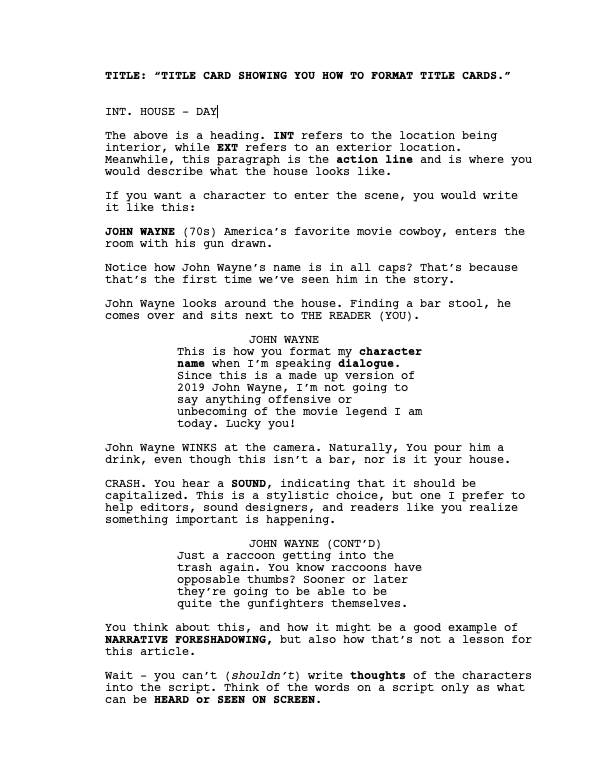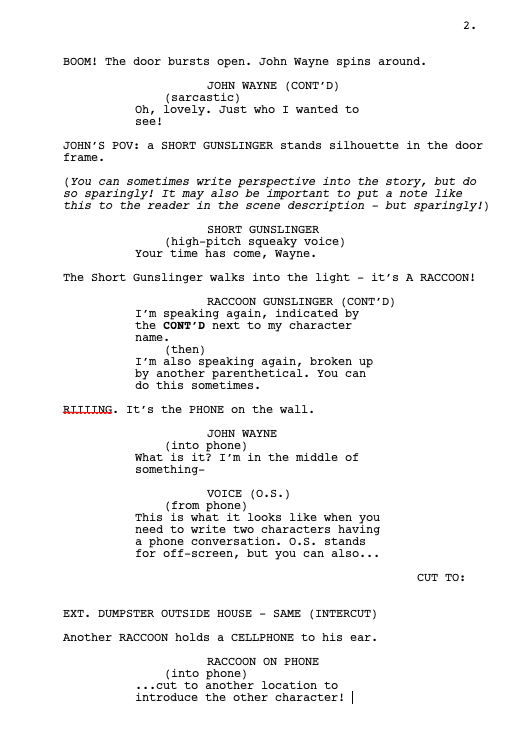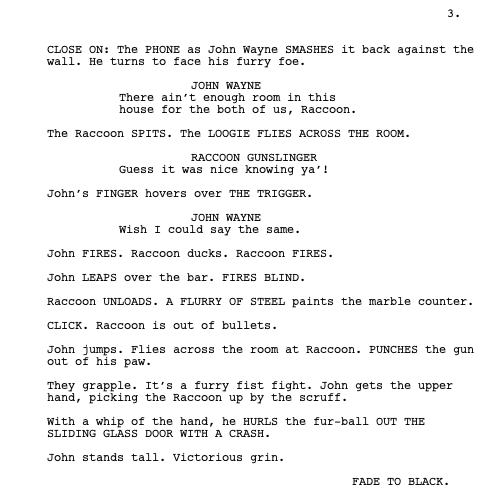Screenplay format is a standardized structure that writers use to convey the story of a film in written form. The format allows filmmakers, actors, and other production team members to visualize the narrative and understand the flow of the story, dialogue, and action.
The formatting elements, like scene headings, character headings, dialogue, and transitions, are unique to the visual nature of screenplays.
Because screenplays are used as a blueprint that the entire film crew uses to inform their creative decisions, they must be written in a visual language that is universal in style and format.
This is so any person in any production stage will know what they are reading when referring to a script.
Table of Contents
Formatting The Scene Setting
Scene headings, referred to in shorthand as slug lines, divide up screenplay scenes by location.
Because slug lines are formatted universally, a screenplay reader can easily jump around any script and find their place in the story.
The formatting goes as follows:
“INTERIOR (INT) OR EXTERIOR (EXT). LOCATION – NIGHT OR DAY”
Here’s an example of a very simple slugline:
“EXT. GRANT’S HOUSE – DAY.”
Underneath the slugline, the rest of the scene will take place.
Begin setting the scene by briefly describing the location, along with whatever character and starting action is driving the top of the scene.
Formatting Characters and Dialogue
If a character is introduced, their name should be in ALL CAPS and bolded to let the reader know they are a new character:
JOHN WAYNE (70s) America’s favorite movie cowboy, enters the room with his gun drawn.
When a character speaks, their name will be ALL CAPS and CENTERED in the middle of the page, which screenwriting software should do for you automatically.
Example of a Scene in Action
I wrote an example scene introducing the above rules and a few more. (Quick note – when I introduce a new term in action lines or dialogue, it will be in bold):

Formatting Action Lines
You must limit your description in your action lines to only what the viewer can see or hear in the movie.
That’s because page space on a screenplay is precious. One screenplay page is usually equivalent to one minute of screen time, give or take.
Don’t expect to sell your script if you spend a lot of page count describing what viewers can’t see. Producers are well-versed in the Hollywood way of doing things – including ditching things they feel waste their time.
Plus, unless you are directing the project yourself, directors and actors will typically be the ones to decide the inner thoughts of their characters on the day of filming or in the moment, anyway.
Formatting Parentheticals
Parentheticals indicate that something a character is saying is not how they feel.
Parentheticals are used between a character’s name and their dialogue to inform that dialogue or between sections of a character’s dialogue to indicate a change in tone or action.
For example, if a character is speaking again after they just spoke, you would use a parenthetical next to their name that looks like this:
JOHN WAYNE (CONT’D)
(CONT’D) is short for “continued.”
Or if a character is talking to someone on the phone, when the person on the other line who is heard but not seen speaks, you would use a parenthetical next to their name to indicate they are not on screen.
That looks like this:
CLINT EASTWOOD (O.S.)
O.S. is abbreviated from “off-screen.”
You can also use a parenthetical to explain something technical to the reader by italicizing it.
You can do this in the dialogue or the scene description to indicate that it isn’t part of the action.
Fx, if a particular character speaks in a different language.
Again, this is a personal style choice, but I think this looks cleanest.
Formatting Transitions and Beats
Transitions like CUT TO: or FADE OUT: which are always capitalized and right-hand justified:

Notice how I put the time of day as SAME in the slugline above to indicate it is happening simultaneously.
I also used the parenthetical (INTERCUT) after the time of day to indicate that the camera will cut back and forth between both locations as the characters continue.
Using “Intercut,” you don’t have to use a new slugline every time one character does an action. This helps make it clear that the conversation is happening in one scene.
Pro tip: By using the parenthetical “(then)” in dialogue, as I do in John Wayne’s second line, you are creating the same effect as writing “(beat)” without being so obvious about it.
Writing “Shots” – Do or Don’t?
Don’t write things like “CLOSE UP SHOT” unless you are directing the movie.
If you write your sentences from the perspective of a specific shot in mind, your words should naturally guide the production crew to see what you see.
Sometimes, you may use shorthand like CLOSE ON or BIRDS EYE to indirectly indicate the point of view you want the reader to view a scene or specific image from.
Here’s a short example of wrapping up our scene between John Wayne and the Racoons:

Free Download Example
And there it is. If you are interested in reading the whole script in its totality, you can download and read it by clicking here:
For those at home cheering for the Racoon, don’t worry: this fight is, surely, not over.
He’ll be back to fight another day again with his other raccoon friend as a backup. Perhaps a raccoon ambush will await John Wayne next time he settles at a campfire out in the bush? Stay tuned…
Back on the subject: to learn the ins and outs of writing a screenplay that works, it’s always best to try it yourself.
However, it’s probably not wise to jump into a feature. Instead, start on a small scale by writing a short film first!

